Europe Beverage Packaging Market Size
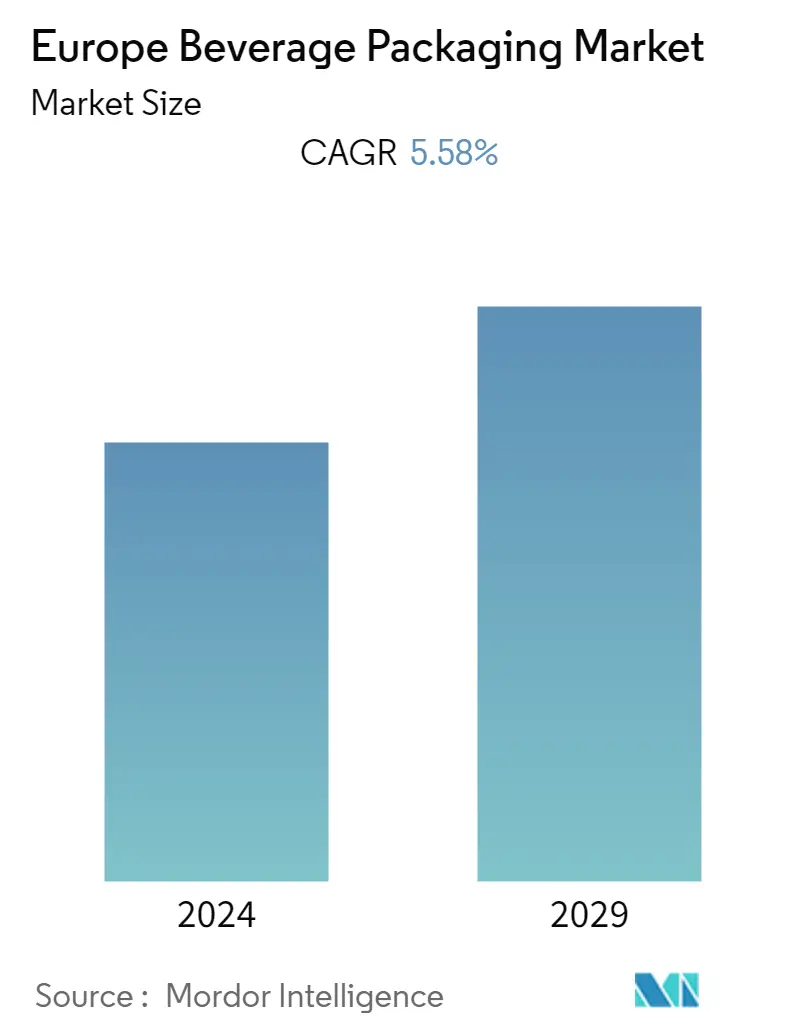
| Study Period | 2019 - 2029 |
| Base Year For Estimation | 2023 |
| Forecast Data Period | 2024 - 2029 |
| Historical Data Period | 2019 - 2022 |
| CAGR | 5.58 % |
| Market Concentration | Low |
Major Players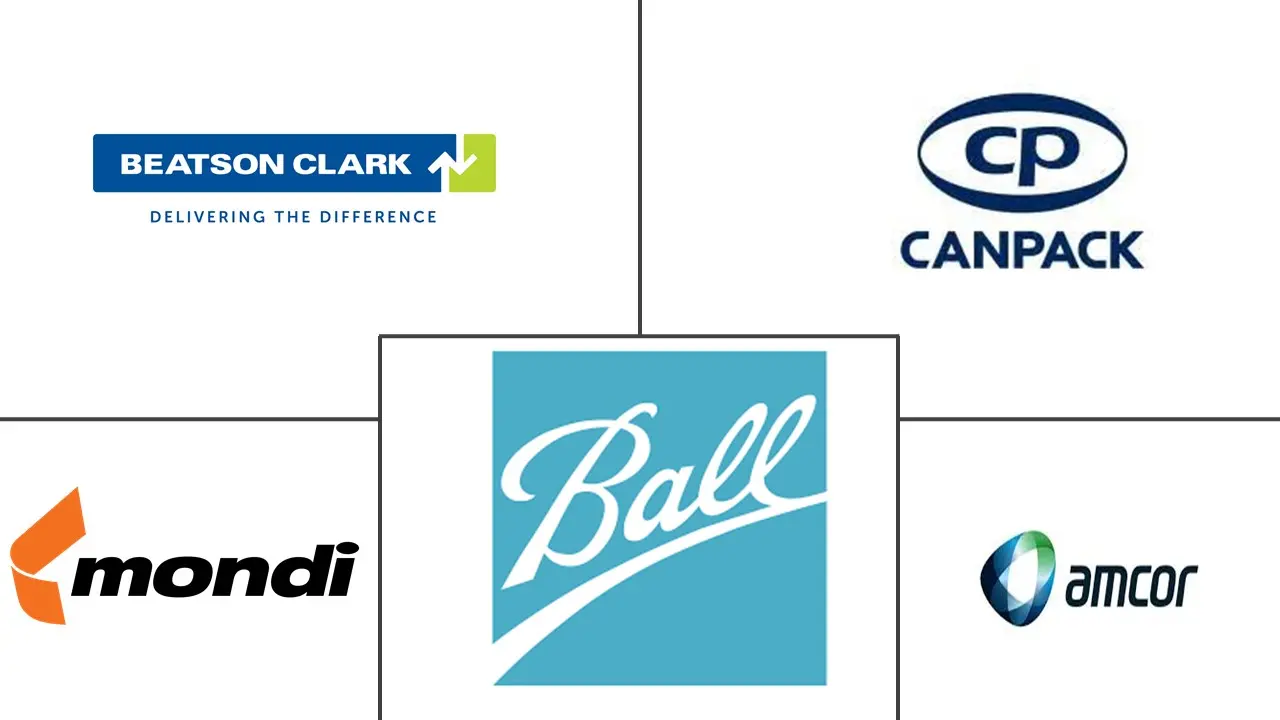
*Disclaimer: Major Players sorted in no particular order |
Europe Beverage Packaging Market Analysis
The Europe Beverage Packaging market is expected to register a CAGR of 5.58% over the forecast period (2021 - 2026). The impact of the COVID-19 outbreak in the region was severe, and the effects were observed in the packaging industry. Offline food chains, such as restaurants and cafes, have been entirely shut down, leading to a decline in demand for beverages. On the contrary, beverages, such as milk products, are witnessing increasing demand as consumers rush to stock the pantries.
- In the European region, the beverage industry plays a critical role. Consistently rising population and per capita income, and changing lifestyles are the key drivers driving the beverage industry's expansion in the region. The demand for healthier food alternatives, such as fresh milk, is increasing because this type of milk is considered more nutritious and more beneficial than shelf-stable milk.
- Flexible beverage packaging is being driven by the quickly embraced trend of lightweight packaging materials and the desire to reduce production, transportation, and handling costs. Furthermore, the rise of e-commerce, which focuses on visually appealing packaging trends, is driving demand.
- Furthermore, with an expected steady increase in alcohol consumption after the lockdown restrictions are eased out, Europe is expected to see more focus on off-premise consumption compared to on-premise consumption. The off-premise consumption of alcohol is favorable for the growth of the packaging market. Alcoholic beverages packaged in pouches for single-serve consumption are a few notable examples that have become increasingly popular in the studied market.
- However, Suntory, the beverage giant in the region, has pledged to eliminate virgin plastics, such as fossil-fuel-based plastics, from its packaging portfolio, by 2030. Such initiatives from other industry players may limit the growth of the market during the forecast period.
Europe Beverage Packaging Market Trends
This section covers the major market trends shaping the Europe Beverage Packaging Market according to our research experts:
Plastic Packaging Significance in Beverage Industry
- The reduction of material in the blow-molded Plastic containers is driven by cost reduction (material and transportation) and the increasing consumer demand for sustainable packaging. In Europe, there is a significant latent potential for the barrier PET bottles in wine, beer, and specialty alcoholic beverages where the penetration of plastic bottles is very low.
- Moreover, of all the types of plastic, it is believed that using PET will help in manufacturing the lightest bottle and container. PETRA is a clear, strong, and lightweight plastic widely used for packaging beverages, especially convenience-sized soft drinks, juices, and water. Virtually all single-serving and 2-liter bottles of carbonated soft drinks and water sold in the United Kingdom are made from PET.
- In 2015, the European Commission issued the EU plastic bags directive to reduce single-use plastic bag usage from 200 per person to 80 per person by 2020 and 40 per person by 2025. This step, coupled with the single-use plastic directive, which aims to ban expanded polystyrene food containers, beverage containers, and cups by 2021, provides an opportunity for vendors to invest in recyclable plastics.
- The beverage companies are also focusing on adopting recyclable plastic packages to create a sustainable beverage ecosystem, which is likely to reduce hazardous waste in the economy. The PET recycling companies are also expanding their reach in Europe by establishing new facilities in the region.
- For instance, in February 2020, Biffa, a large waste management provider based in the United Kingdom, established a new 27.5 million pound state-of-the-art (SOA) polyethylene terephthalate (PET) bottle recycling plant in Seaham, England. The new facility is capable of converting 57,000 metric tons of tonsPET plastics annually.
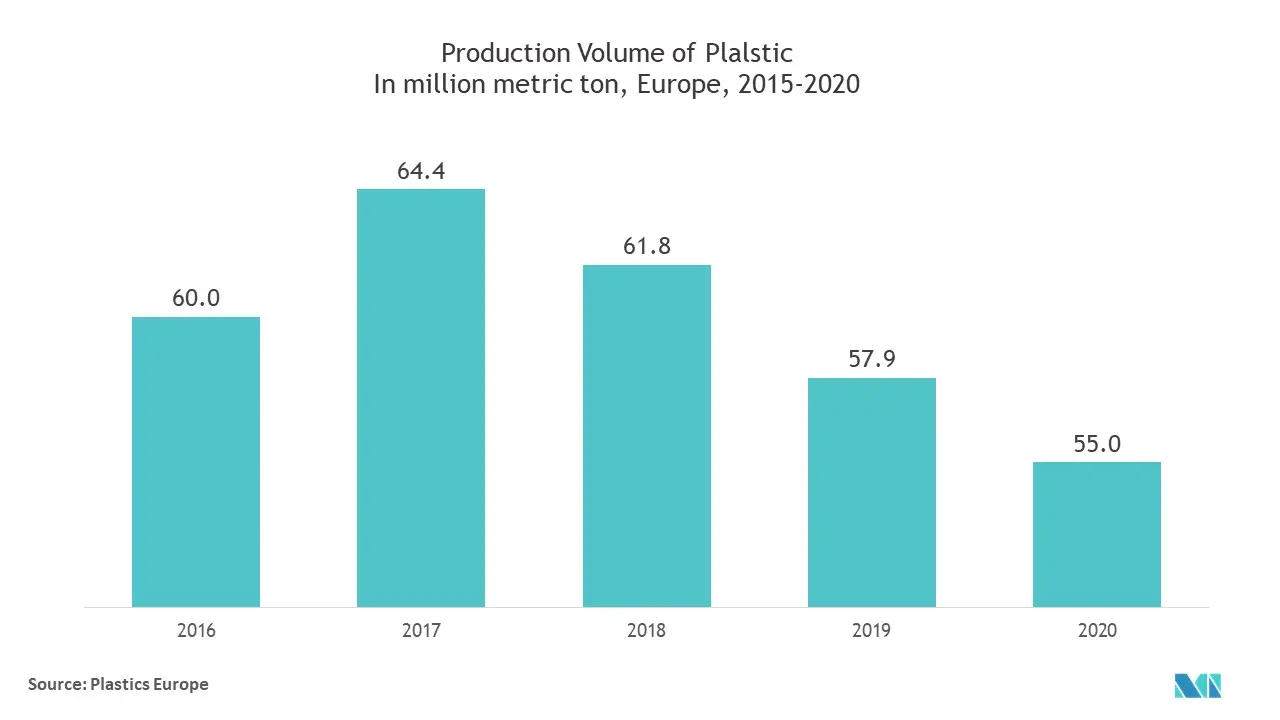
Bottles are observing significant Increase
- The logistics aspect of the liquor packaged in glass bottles is challenging the growth. As glass is comparatively more cumbersome and prone to breakage during transport, increasing the chances of goods loss; however, vendors are trying to innovate the packaging aspect of glass bottles. For instance, Nakpack provides systems specific to wine glass bottle packaging safety, allowing a single model of packaging to be used with various bottle types and formats.
- Moreover, even producers of liquor, such as gin, are also facing issues with the weight of glass bottles used in the packaging of their products; To tackle this, Bruni Glass France is offering lighter glass bottles to gin manufacturers and heavier and thick-bottomed glass bottles for cognac.
- More and more liquor manufacturers are becoming conscious of using recycled materials in their packaging and increasing the percentage of recycled glass used in their bottles. For instance, Absolut has vowed to minimize the packaging waste by launching a limited-edition design made from 41% recycled glass.
- The global dairy industry has been witnessing a backward shift from plastic to glass bottles. Driven by consumer demand for environmentally friendly milk, many small dairy market players choose to sell their products in reusable bottles. The demand for glass bottles in the milk industry has been increasing more in Europe when compared to other regions.
- DiaryDrop, based in Alderly Edge, which has 3,000 customers in Cheshire, announced a significant reversal in the glass milk bottle delivery trend. Another Cheshire-based milk supplier, Creamline Dairies, witnessed an increase of 85% in the number of people getting glass bottles delivered last year.
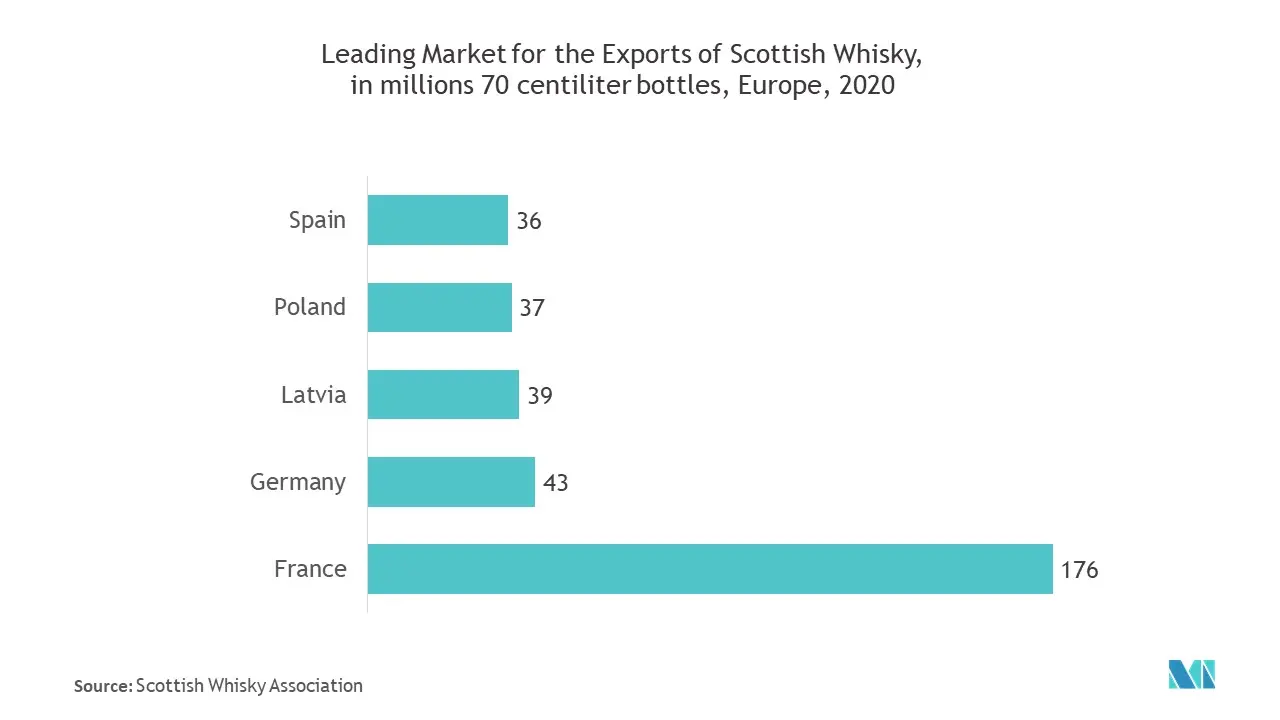
Europe Beverage Packaging Industry Overview
The European beverage packaging market is fragmented due to many players are entering the packaging market. Moreover, innovation and development by players are making the market competitive. Some of the key developments in the market are:
- May 2020 - the European Wine industry sets a glass recycling goal. The Comité Européen des Entreprises Vins (CEEV) has partnered with a Europe-wide group to have a 90% glass recycling rate by 2030. The CEEV plans to collaborate with other group members, targeting a goal of collecting 90% of all glass packaging in the EU market for recycling in a "bottle-to-bottle closed-loop" by 2030. Also, 76% of all glass packaging in the EU is currently recycled, according to FEVE
- December 2020 - Vetropack acquired Moldovan glassworks in Chişinău, Moldova. The Chișinău glassworks produces approximately 100,000 tonnes of glass packaging annually for the food and beverage industry, sold domestically and for export. Further, the acquisition will enhance the market position in Central and Eastern Europe.
- December 2020 - Berlin Packaging acquired New pack, a leading glass packaging company based in Savona, Italy. The acquisition of New pack allows Berlin Packaging to increase its offering in the wine sector, an important market in Europe.
Europe Beverage Packaging Market Leaders
-
Amcor Plc
-
Ball Corp
-
Beatson Clark Ltd
-
CANPACK Group
-
Mondi Group Plc
*Disclaimer: Major Players sorted in no particular order
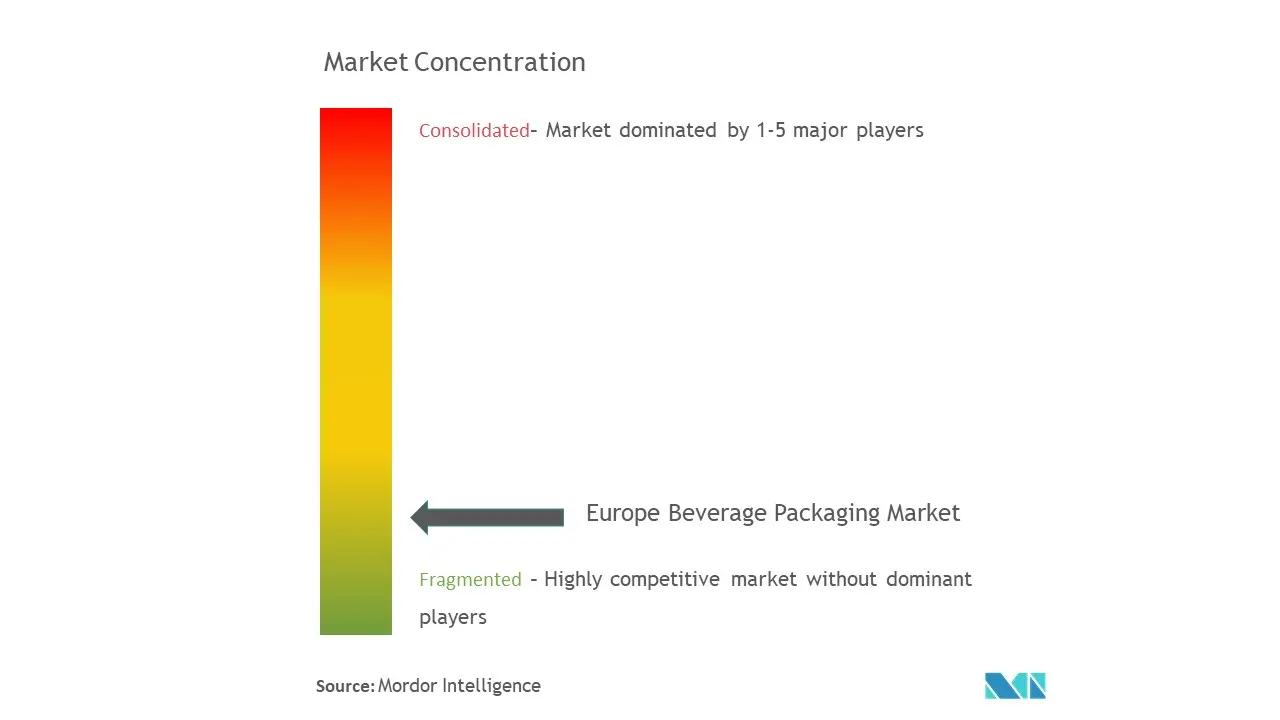
Europe Beverage Packaging Market News
February 2021 - BOPET Films Europe and Searious Business launched Vita Nova, a new consortium to promote the use of mono-PET flexible packaging in the circular economy. Such consortiums are expected to play a vital role in the region's wide adoption of flexible beverage packaging.
July 2021 - With new cutting-edge facilities in the UK and Russia, Ball Corporation, one of the world's top manufacturers of infinitely recyclable aluminum beverage packaging, plans to enhance its manufacturing capacity dramatically.
Europe Beverage Packaging Market Report - Table of Contents
1. INTRODUCTION
1.1 Study Assumptions
1.2 Scope of the Study
2. RESEARCH METHODOLOGY
3. EXECUTIVE SUMMARY
4. MARKET INSIGHTS
4.1 Market Overview
4.2 Industry Value Chain Analysis
4.3 Industry Attractiveness - Porter's Five Forces Analysis
4.3.1 Bargaining Power of Suppliers
4.3.2 Bargaining Power of Consumers
4.3.3 Threat of New Entrants
4.3.4 Threat of Substitute Products
4.3.5 Intensity of Competitive Rivalry
4.4 Market Drivers
4.4.1 Improved Technology Offering Better Solutions
4.5 Market Restraints
4.5.1 Operation and Logistical Concerns
5. IMPACT OF COVID-19 ON THE BEVERAGE PACKAGING INDUSTRY
6. MARKET SEGMENTATION
6.1 By Material Type
6.1.1 Plastic
6.1.2 Metal
6.1.3 Glass
6.1.4 Paperboard
6.2 By Product Type
6.2.1 Bottles
6.2.2 Cans
6.2.3 Pouches
6.2.4 Cartons
6.2.5 Beer Kegs
6.3 By Application
6.3.1 Carbonated Drinks
6.3.2 Alcoholic Beverages
6.3.3 Bottled Water
6.3.4 Milk
6.3.5 Fruit and Vegetable Juices
6.3.6 Energy Drinks
6.3.7 Plant-based Drinks (Emerging Market)
6.3.8 Other Applications
6.4 By Country
6.4.1 United Kingdom
6.4.2 Germany
6.4.3 France
6.4.4 Italy
6.4.5 Spain
6.4.6 Austria
6.4.7 Poland
6.4.8 Russia
6.4.9 Rest of Europe
7. COMPETITIVE LANDSCAPE
7.1 Company Profiles
7.1.1 Amcor Plc
7.1.2 Ardagh Group SA
7.1.3 Ball Corp.
7.1.4 Beatson Clark Ltd
7.1.5 CANPACK Group
7.1.6 Danone SA
7.1.7 Gerresheimer AG
7.1.8 Mondi Group Plc
7.1.9 Smurfit Kappa Group
7.1.10 Sonoco Products Co.
7.1.11 Stora Enso Oyj
7.1.12 Tetra Pak International SA
7.1.13 Vidrala SA
- *List Not Exhaustive
8. INVESTMENT ANALYSIS
9. FUTURE OF THE MARKET
Europe Beverage Packaging Industry Segmentation
The study analyzes the demand for the Beverage packaging industry in Europe, based on the following segments, by Material Type (Plastic, Metal, Glass, PaperBoard). by Product Type (Bottles, Cans, Pouches, Cartons, Beer Kegs), by Application (Carbonated Drinks, Alcoholic Beverages, Bottled Water, Milk, Fruit and Vegetable Juices, Energy Drinks, Plant-Based Drinks, and Other Applications) and by Country.
| By Material Type | |
| Plastic | |
| Metal | |
| Glass | |
| Paperboard |
| By Product Type | |
| Bottles | |
| Cans | |
| Pouches | |
| Cartons | |
| Beer Kegs |
| By Application | |
| Carbonated Drinks | |
| Alcoholic Beverages | |
| Bottled Water | |
| Milk | |
| Fruit and Vegetable Juices | |
| Energy Drinks | |
| Plant-based Drinks (Emerging Market) | |
| Other Applications |
| By Country | |
| United Kingdom | |
| Germany | |
| France | |
| Italy | |
| Spain | |
| Austria | |
| Poland | |
| Russia | |
| Rest of Europe |
Europe Beverage Packaging Market Research FAQs
What is the current Europe Beverage Packaging Market size?
The Europe Beverage Packaging Market is projected to register a CAGR of 5.58% during the forecast period (2024-2029)
Who are the key players in Europe Beverage Packaging Market?
Amcor Plc, Ball Corp, Beatson Clark Ltd, CANPACK Group and Mondi Group Plc are the major companies operating in the Europe Beverage Packaging Market.
What years does this Europe Beverage Packaging Market cover?
The report covers the Europe Beverage Packaging Market historical market size for years: 2019, 2020, 2021, 2022 and 2023. The report also forecasts the Europe Beverage Packaging Market size for years: 2024, 2025, 2026, 2027, 2028 and 2029.
Europe Beverage Packaging Industry Report
Statistics for the 2024 Europe Beverage Packaging market share, size and revenue growth rate, created by Mordor Intelligence™ Industry Reports. Europe Beverage Packaging analysis includes a market forecast outlook 2029 and historical overview. Get a sample of this industry analysis as a free report PDF download.



